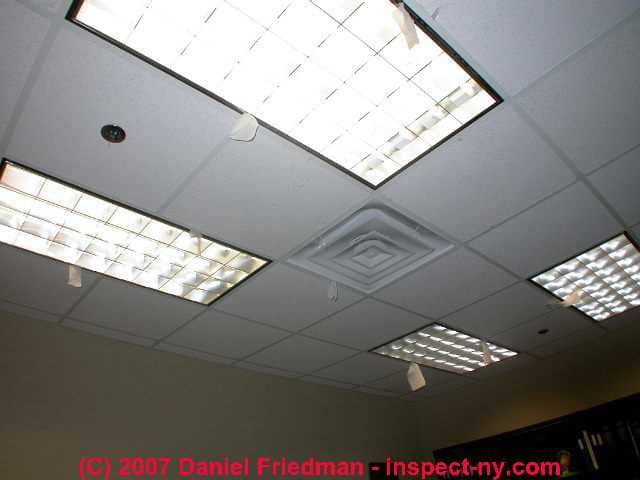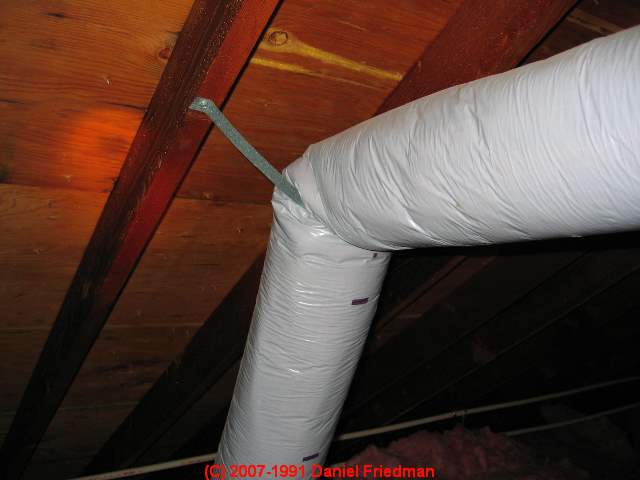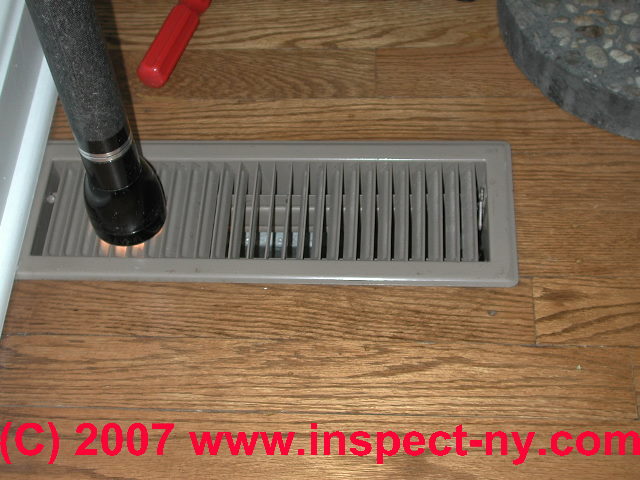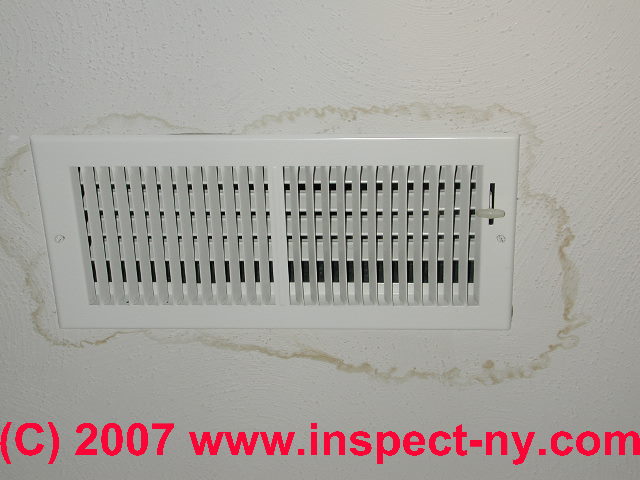 Diagnose & Fix HVAC Air Duct Problems
Diagnose & Fix HVAC Air Duct Problems
Duct air flow problems noises water or condensate
- POST a QUESTION or COMMENT about air conditioner or heat pump system cooling diagnosis & repair
Diagnose & cure HVAC duct problems like weak air flow, leaks, noises, condensation:
If not enough cool air is provided by your air conditioner, or if the air temperature is not cool enough, or if you just can't get your A/C unit running, this article helps diagnose and correct the problem with step by step things to check and links to more detailed explanation when you need it.
This article forms part of our series on how to diagnose an air conditioner or heat pump that is not cooling.
InspectAPedia tolerates no conflicts of interest. We have no relationship with advertisers, products, or services discussed at this website.
- Daniel Friedman, Publisher/Editor/Author - See WHO ARE WE?
Air Conditioning Air Duct Problems and Air Flow Defects - Poor Air Flow
 Damaged air conditioning ducts (or heating ducts if you are diagnosing weak heating air flow) such as ducts which have been improperly routed and are crimped, crushed, or have
excessive bends can reduce cool air flow in an otherwise properly functioning system.
Damaged air conditioning ducts (or heating ducts if you are diagnosing weak heating air flow) such as ducts which have been improperly routed and are crimped, crushed, or have
excessive bends can reduce cool air flow in an otherwise properly functioning system.
You've already checked the suggestions made at AIR FLOW TOO WEAK, right?
If not please do so. It may save some trouble.
Quick List of the Most Common HVAC Duct Defects that impair air flow
- Crimped flex-duct (photo at left)
- Disconnected ductwork
- Leaky ductwork - tears, holes
- Undersized or poorly located return air
- Ductwork runs too long
- Ductwork with unnecessary bends or lengths of unneeded but left-in-place flex-duct
Watch out: Don't forget to check the easy stuff first: A client asked us to drive a considerable distance to repair her apartment's central air conditioning system after having had several unsuccessful service calls by local repairmen.
Because access was difficult and nasty, the first fellows who had been called preferred to stand in the apartment and suggest easy but irrelevant remedies like "adding refrigerant" (balderdash!) but
no one had managed to get into the rather tight and hard-to-enter attic crawl space where the cooling ducts were routed.
For one thing, you needed to bring a ladder, climb to a high scuttle hole, and remove the screws of an access panel.
We had our trusty Little Giant ladder and made the climb, bringing along a flashlight and a screwdriver. In the scuttle opening we found that the main cooling duct had become completely disconnected.
The attic was nice and cool but no cool air was being blown
into the living area.
Check the condition of the duct system for blocked ducts, loose leaky connections, closed dampers, crimps and bends, before calling your service technician.
See DUCT SYSTEM DEFECTS for details of various A/C supply and return air duct and register problems and how to detect and correct them.
Cooling Capacity of the Air Conditioning Duct System vs Ductwork
Even if a very high BTUH capacity cooling system is installed, if the duct system is defective the ability of the system to deliver cool air to the occupied space can be severely or even totally lost.
Duct System Efficiency
(in percent) describes the percent of cooled air produced by the A/C equipment which is actually delivered to the occupied space. This number is less than 100% because of air flow restrictions and losses in the duct work.
Duct Delivery Effectiveness
is the percent of cooling capacity which is delivered through the registers into the occupied space.
Registers themselves restrict air flow.
See DUCT SYSTEM & DUCT DEFECTS.
Cooling Capacity of the Whole Air Conditioning System
So the ability of the entire A/C system to cool a building or rooms in it requires that both the cooling equipment and the duct system be in proper working order.
Details about duct system and air handler diagnosis, including duct defects, air filter defects, and air handler problems are provided
at AIR HANDLER UNIT: problems with the air handler, air filters, and the cooling coil itself.
Is there no cool air at all coming out of the supply registers?
Or is there air blowing out of the supply registers but it's not cool enough?
Here we explain how to diagnose loss of air conditioning cool air flow or cool air temperature.
Before ordering an expensive air conditioner service call to restore lost cooling capacity, here are a few simple steps to perform.
Some of these can be done by any homeowner, others may require a bit more expertise.
Other Causes of Weak A/C or Heat Airflow Blamed Misdiagnosed as a Duct System Defect
Weak Air Flow due to Dirty Air Filters
If your air conditioning equipment is running but little or no cool air is coming out of the supply registers, check that your air filter(s) have not become blocked with dirt and debris.
Usually the air filter is right at the air handler or blower unit, or your air filter may be installed behind a grille covering a central warm-air return that sends air back to the air handler.
See AIR FILTERS for HVAC SYSTEMS
for details
Ceiling Stains due to Condensation or Ice Leaks
At above left you can see a ceiling air supply register that has leak stains around its opening - further investigation for a condensate leak or roof leak is needed.
Accidental airflow through an idle ceiling duct system in winter can cause accumulation of condensation and ice.
Poor or missing insulation on an attic duct system can also cause excessive in-duct condensation and leaks such as the stain shown here.
Air Flow Too Weak, Too Cold, or Too Warm

Details about diagnosing and fixing too-weak air flow from HVAC systems are
at AIR FLOW TOO WEAK
Air Conditioner Blower fan unit not moving enough air:
too little air coming out of your air conditioning ducts?
Check the condition of the blower unit:
if it's dirty the blower may be spinning but not moving much air.
See DIRTY A/C BLOWERS for details.
Dirty filters or iced coils
or crimped or disconnected air ducts can also cause loss of cool air or too little cool air coming out of supply registers.
These items are addressed below in this air conditioner diagnostic guide.
Also see DIRTY COOLING COIL / EVAPORATOR COIL
and FROST BUILD-UP on AIR CONDITIONER COILS.
Sketch courtesy of Carson Dunlop Associates, a Toronto home inspection, education & report writing tool company [ carsondunlop.com ].
Air flow that is too slow
for any reason (such as a dirty filter or dirty blower fan assembly blades) can cause first, air temperatures that are abnormally low coming out of the air conditioner, and eventually a reduction in air flow as coil ices over.
Air flow that is too fast
for any reason (improper fan motor, speed, fan belt or pulley size, duct design, duct registers removed, etc) can produce air that is not cool enough and can prevent proper air dehumidification (oversized A/C system).
Air Conditioner Cooling Coil Icing Problems & Coil Leaks

Several causes of cooling or evaporator coil icing all have the same effect: ice blocks air flow across the coil, resulting in weak air delivery during the cooling season.
For a detailed discussion of air conditioner or other refrigeration (or dehumidifier) cooling
coil ice-up diagnosis and cure,
see FROST BUILD-UP on AIR CONDITIONER COILS
Also see REFRIGERANT LEAK DETECTION
If your air conditioner or heat pump is a split system or mini split system design (using a wall-mounted cooling or heating unit) our troubleshooting diagnostics are
at SPLIT SYSTEM AIR CONDITIONERS & HEAT PUMPS.
This discussion is now found at COOL AIR SUPPLY IMPROVEMENT
Get More Warm Air Flow
This topic is discussed at WARM AIR SUPPLY TEMPERATURE & IMPROVEMENT
...
...
Continue reading at SUPPLY DUCT AIR LEAKS or select a topic from the closely-related articles below, or see the complete ARTICLE INDEX.
Or see DUCT & AIR FLOW PROBLEMS FAQs for questions & answers about HVAC duct problems that were posted originally on this page.
Or see these
Recommended Articles
Suggested citation for this web page
DUCT & AIR FLOW PROBLEMS at InspectApedia.com - online encyclopedia of building & environmental inspection, testing, diagnosis, repair, & problem prevention advice.
Or see this
INDEX to RELATED ARTICLES: ARTICLE INDEX to HVAC DUCT SYSTEMS
Or use the SEARCH BOX found below to Ask a Question or Search InspectApedia
Ask a Question or Search InspectApedia
Try the search box just below, or if you prefer, post a question or comment in the Comments box below and we will respond promptly.
Search the InspectApedia website
Note: appearance of your Comment below may be delayed: if your comment contains an image, photograph, web link, or text that looks to the software as if it might be a web link, your posting will appear after it has been approved by a moderator. Apologies for the delay.
Only one image can be added per comment but you can post as many comments, and therefore images, as you like.
You will not receive a notification when a response to your question has been posted.
Please bookmark this page to make it easy for you to check back for our response.
IF above you see "Comment Form is loading comments..." then COMMENT BOX - countable.ca / bawkbox.com IS NOT WORKING.
In any case you are welcome to send an email directly to us at InspectApedia.com at editor@inspectApedia.com
We'll reply to you directly. Please help us help you by noting, in your email, the URL of the InspectApedia page where you wanted to comment.
Citations & References
In addition to any citations in the article above, a full list is available on request.
- In addition to citations & references found in this article, see the research citations given at the end of the related articles found at our suggested
CONTINUE READING or RECOMMENDED ARTICLES.
- Carson, Dunlop & Associates Ltd., 120 Carlton Street Suite 407, Toronto ON M5A 4K2. Tel: (416) 964-9415 1-800-268-7070 Email: info@carsondunlop.com. Alan Carson is a past president of ASHI, the American Society of Home Inspectors.
Thanks to Alan Carson and Bob Dunlop, for permission for InspectAPedia to use text excerpts from The HOME REFERENCE BOOK - the Encyclopedia of Homes and to use illustrations from The ILLUSTRATED HOME .
Carson Dunlop Associates provides extensive home inspection education and report writing material. In gratitude we provide links to tsome Carson Dunlop Associates products and services.




